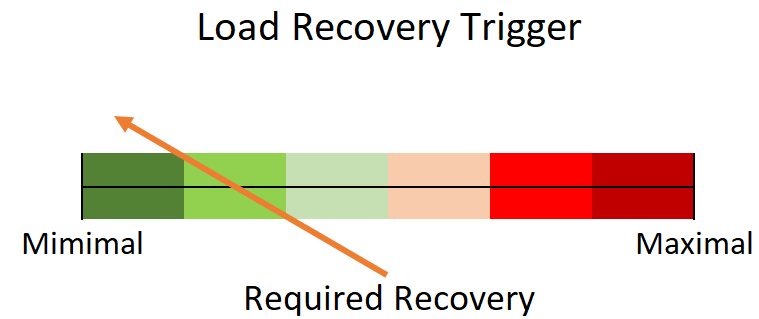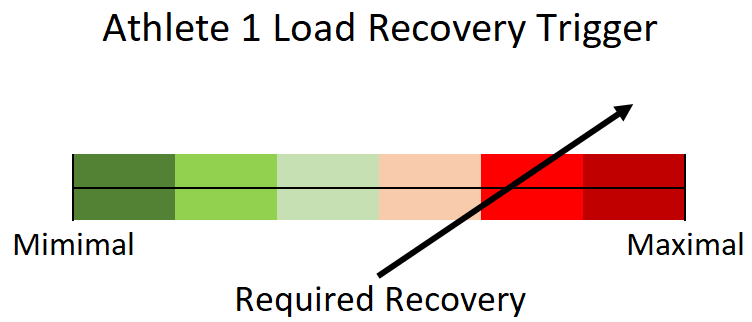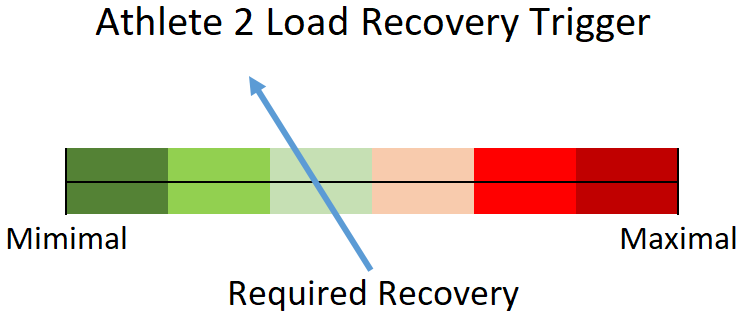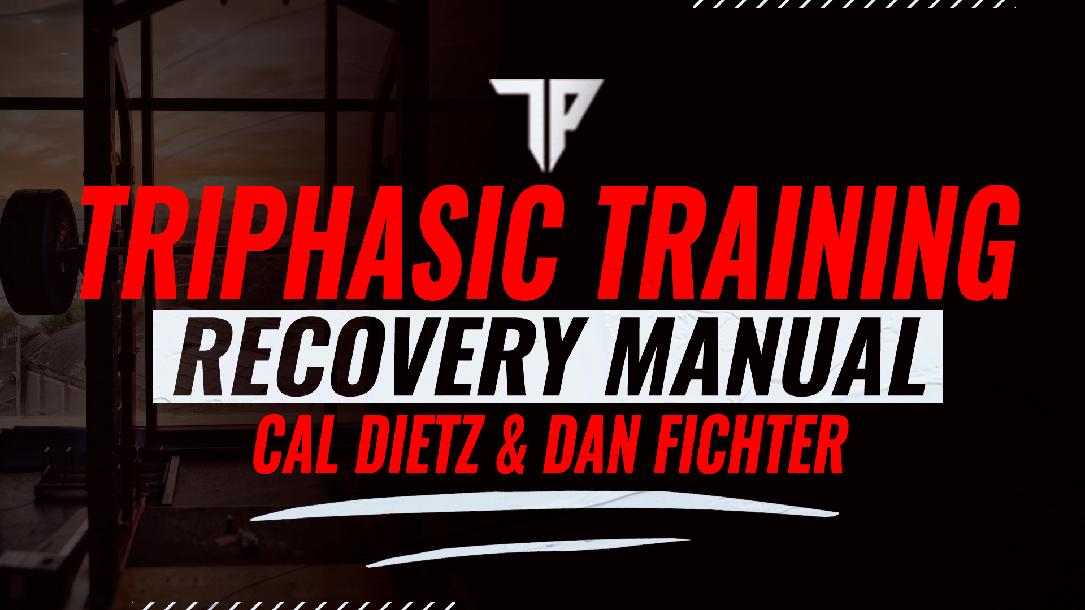1
Lesson 2:
1.0 Understanding and Applying Recovery Appropriately
Section 1 - Understanding and Applying Recovery Appropriately
Section Outline
Introduction to “Load Recovery Trigger”
Importance of Appropriate Training as a Recovery Strategy
Application of Recovery Based on Specific Needs
Primary Considerations of Recovery Application
Section Objectives
Section 1 provides a conceptual overview of the appropriate and specific requirements of applied recovery modalities. Coaches understand stress in regards to creating adaptation, but rarely apply recovery methods with the same specificity. The “Load Recovery Trigger”, which allows a coach to conceptually “view” the amount of recovery required of an athlete in a continuum fashion, is introduced in this opening section. Recovery is not required, or even desired, after every training session and should be approached on an individual needs basis. This is particularly true during off-season training, which is capable of serving as one of the greatest recovery strategies during the competitive season. However, when recovery is needed, the type, amount, and timing of its application become imperative in repeated, optimal performance. Coaches must continue to seek the physiological systems being placed under stress throughout training and competition, and then be capable of monitoring them and applying recovery modalities on an individual basis. Only when this occurs will the highest level performance throughout the duration of a grueling competitive season be consistently possible.
The aspects of stress and its application to training are, for the most part, well understood throughout the coaching world. If a coach wishes for an athlete to gain strength, lifting methods are applied via progressive overload to achieve this change. If the ability to change direction is desired, agility, plyometric, and other programming options are applied to realize this goal. However, the application of recovery methods is much less understood and rarely programmed in a systematic process. This manual provides multiple recovery methods all coaches have available to them, in order to repeatedly allow athletes to perform optimally. The likelihood of this repeated optimal performance can be enhanced through the understanding of the “Load Recovery Trigger”.
This “Load Recovery Trigger” will be utilized throughout this manual. This term simply means that recovery of some kind is potentially required. This “Load Recovery Trigger” functions on a continuum and is not an “all-or-none” in regards to the applied modalities. This continuum can be seen in figure 1.1 below. If the athlete has experienced relatively low amounts of stress (from either internal or external measures), they will not require much, if any recovery. As stress is applied at a higher level, particularly to a level an athlete has not been prepared for, increased amounts of recovery will be required to prepare them for the upcoming training session. It is also critical to note we are not saying an athlete should be completely recovered for every training session implemented. It is the stress that is continuously, yet appropriately, applied that leads to long-term athletic development. Clearly planned and appropriately executed forms of periodization are necessary to achieve this in athletes.

Figure 1.1: Load Recovery Trigger Continuum. This continuum provides the amount of recovery required by an athlete when compared to previous testing and/or monitoring.
We, as coaches, must apply a great enough stress to the athlete prior to concerning ourselves with specific recovery modalities. If an athlete is consistently focusing on only the recovery aspect and not training, their adaptations are likely to be less than optimal.
The stress applied through training can be monitored through multiple methods of measurement, including but not limited to, wellness questionnaires, RPE, heart rate, ANS tracking, and GPS data. Each of these means of measurement provide a different clue or insight as to what is occurring within an athlete’s body due to the training completed. If there is a large change to one of these monitoring methods, a “Load Recovery Trigger” is “set off” to indicate to a coach an athlete has experienced a stressor, or response they are not accustomed, or adapted, to.
Examples of these changes that can be seen below:
Gait pattern when simply walking has been altered for some reason, such as a “toe in” walk.
The GPS load increases in some athletes, but the general practice load is down for the majority of the team.
The heart rate of an athlete or team increases (higher internal load) while the external load (GPS or RPE) remains at the normal level.
Drastic changes in sleep amount or quality (increased or decreased) across a group of athletes or team.
Again, the amount of recovery required by an athlete will function on a continuum and will be dependent upon their training history. With high-level training programs, athletes will be capable of tolerating large training loads with no required recovery, simply due to their high level of preparedness and appropriate progressions being applied.
A simple example of this change in stress is the start of a pre-season NFL training camp. All athletes across an entire team are required to complete the same rigorous practice schedule with the ultimate goal of keeping their job. We are going to look at two athletes who play defensive back and experience the same number of plays. Athlete 1 completed an off-season training program that consisted of running long distances, very rarely at high speeds in order to “stay in shape”. On the other hand Athlete 2 completed a high-intensity training program that included high speed running and change of direction.
Upon arriving to training camp, both players are able to pass their conditioning test as they both appear to be “fit”. However, after the first two practices the two athletes have entirely different requirements in regards to recovery. As the high speed yards and rapid changes of direction accumulate during coverage and team drills, Athlete 1 begins to fall behind or worse, pulls a hamstring. At this point Athlete 1, unless he is a seasoned veteran and elite level performer, is likely out of a job.
Now this is in no way making a statement that long distance running is “bad” or that the aerobic system is unnecessary as an underlying component of recovery, even in football. However, this model does not fit the context of the requirements of an NFL defensive back, particularly if it is applied for the entirety of an off-season training program. Looking at their internal and external responses relative to what was completed in the off-season, these two athletes would likely resemble something similar to the Load Recovery Triggers demonstrated below.

Figure 1.2: Athlete 1 and their recovery requirements after just the first few days of practice. This athlete requires large amounts of tissue recovery due to them being unprepared for the high speed yardages of an NFL DB.

Figure 1.3: Athlete 2 and their recovery requirements after just the first few days of practice . This athlete does not require extensive amounts of recovery due to a well created off-season training regime.
Due to the understanding of the requirements of an NFL defensive back, and the appropriate implementation of training not only is Athlete 2 more prepared to take over as the starter, they are also able to do so with less required recovery. Training serves as the primary factor that creates resiliency within your athletes. If athletes are not prepared appropriately, no amount of recovery is going to allow them to repeatedly compete at the highest levels possible.
This “Load Recovery Trigger” can be “set off” when any measured aspect of training (internal or external) experiences a rapid change, or a stress that is applied that is too high relative to the athlete’s previous experiences. Again this trigger could be activated with any measured variable a coach has available and deems valuable. Heart rate, RPE, and the ANS (HRV) are simple internal measures, while GPS data, such as high speed yards in the example above, serve as potential external data points. Regardless of the selected parameter, the understanding of “what is required” will allow a training program that progresses an athlete appropriately. Coaches should ultimately be looking for large changes in these parameters to determine athlete recovery needs while also understanding the stressors they are applying in training.
The high-level use of this continuum requires the comprehension of the basic aspects of stress and the organism’s response to it. The General Adaptation Syndrome “GAS” is only one aspect, which is commonly understood by coaches (although a brief refresher will be addressed here). Timing of the recovery method is also critical to ensure the adaptations realized due to training are not blunted.
This has now been demonstrated with the overuse of anti-oxidants and their ability to reduce adaptations due to training. An athlete that is constantly “over-recovering” is actually making training “easier” on their body. The blunting of adaptations realized due to antioxidant consumption immediately following training is one example of this “over-recovery”. Rather than taking antioxidants immediately post-training, they should aim for their use the following morning with breakfast. If stress is the driving force behind the changes realized due to training, we must be cautious to not reduce the effects of the hard work and time by applying inappropriate means or amount of recovery work.
Ultimately performance coaches are stress managers. However, it is also imperative we all understand the physiological stressor(s) we are applying with each training session. Without this knowledge a coach will not know how an athlete should be responding to training, or when to change the program should the response be undesirable. Training is absolutely designed to stress an athlete, as without some type of stress response (visible in GAS) the athlete will not adapt and achieve increased performance. The more coaches understand the role not only general stress, but also specific, applied, training stress, plays in performance, the more effective they will be in implementing recovery aspects of performance. Although this book demonstrates specific examples to utilize in terms of recovery, coaches must first understand the effects of the stressors placed on an athlete in training if optimal results are to be achieved consistently, on an individual athlete basis.
When recovery aspects are implemented with appropriate timing, type, and amount, optimal performance becomes available for each and every athlete being trained. The concepts and specific methods demonstrated throughout this manual should serve as a “piece of the puzzle” to every coach reading. Again, the human organism is by far the most complicated “machine” we are currently aware of. However, when broken into systems, and then those systems are tied back together, its understanding becomes much more manageable. This will be a critical aspect when taking these recovery modalities and applying them with your own athletes.
The goal of this manual remains to provide the framework of both the concepts, and specific means of recovery in a practical, usable form. By the end of this manual, all coaches should understand the systems of the human body being targeted by specific recovery protocols, as well as how these protocols can be utilized within the training model to achieve desired results (optimal performance) at specific moments in time.
The primary aspects of recovery and its application can be broken into three components. These three are listed below:
Type
Amount
Timing
Type of Recovery: This is dependent upon the current status of the athlete and the stressor that was experienced. The recovery methods applied to the NFL athlete’s hamstrings may be more site specific soft-tissue based, while an athlete experiencing a chronic stressor may require a more systemic approach to recovery.
Amount of Recovery: This is determined based upon the current stress being experienced by the athlete and the “Load Recovery Trigger”. If an athlete is experiencing an extreme stressor they have not been prepared for, they will require greater amounts of recovery than one that is experiencing minor stress relative to their preparation.
Timing of Recovery: This is likely the most difficult aspect to determine for a coach. Coaches must constantly consider what state the athlete will be in after the recovery method is applied. For example, something that leads to a drastic increase in parasympathetic drive (massage or excessive foam rolling even) should likely not be applied immediately prior to a high-intensity training session or practice. Ultimately we must ensure this recovery modality will not negatively alter the adaptations expected due to training or the upcoming physical work required.
There is no doubt that athletes push themselves to their limits in both training and performance. These extreme requirements of their body lead to the requirements of these recovery modalities. We commonly utilize the term “rest is a weapon” as athletes do not always enjoy the idea of not going hard all of the time. This is in part due to the “no days off” and other misused terms in our profession and the world of athletics. Rather than focusing on what will lead to the highest level performance, athletes commonly get caught up in “out working” their opponent. There is no doubt that this hard work will lead to performance improvements, but the right type of hard work must also be completed. Simultaneously, if rest is never allowed, injury likelihood increases as an athlete enters a constant state of overtraining.
With all this being said there are still specific times in which we desire athletes to be fatigued. If we consistently make training too easy on our athletes through recovery, their body will never adapt to training at the highest level. Take the cold tub or the excessive use of antioxidants. If you, as a performance coach are preparing them for the next season, your desire is to apply maximal amount of stress each athlete is capable of handling (without causing injury of course). If recovery modalities (such as cold tub or antioxidants) are implemented regularly, the “stress” experienced by the body will be greatly reduced. Returning to GAS, this means the supercompensation experienced will be much less.
3
4
5
6
7
8
9
10
11
12
13
14
15
16
17
18
19
20
21
22
23
24
25
26
27
28
29
30
31
32
33
34
35
36
37
38
39
40
41
42
43
44
45
46
47
48
49
50
51
52
53
54
55
56
57
58
59
60

Triphasic Training Recovery Manual: Transform Your Performance with Expert-Led Training Unlock your full athletic potential with our Triphasic Training Recovery Manual, crafted by renowned coaches Dan Fichter and Cal Dietz. This comprehensive training program is designed to provide athletes with personalized plans and cutting-edge techniques to enhance performance and accelerate recovery. Why C...
